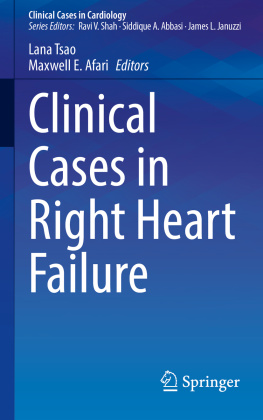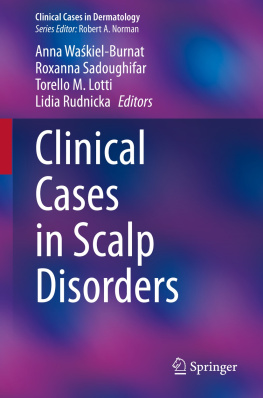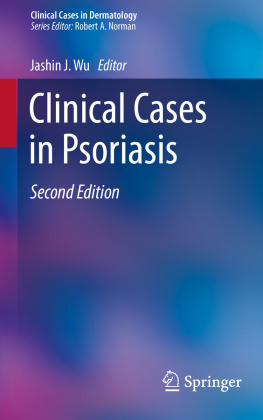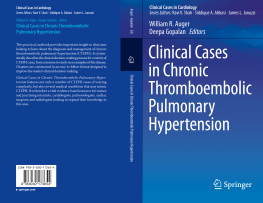Lana Tsao - Clinical Cases in Right Heart Failure
Here you can read online Lana Tsao - Clinical Cases in Right Heart Failure full text of the book (entire story) in english for free. Download pdf and epub, get meaning, cover and reviews about this ebook. year: 2020, publisher: Springer International Publishing, genre: Romance novel. Description of the work, (preface) as well as reviews are available. Best literature library LitArk.com created for fans of good reading and offers a wide selection of genres:
Romance novel
Science fiction
Adventure
Detective
Science
History
Home and family
Prose
Art
Politics
Computer
Non-fiction
Religion
Business
Children
Humor
Choose a favorite category and find really read worthwhile books. Enjoy immersion in the world of imagination, feel the emotions of the characters or learn something new for yourself, make an fascinating discovery.
- Book:Clinical Cases in Right Heart Failure
- Author:
- Publisher:Springer International Publishing
- Genre:
- Year:2020
- Rating:4 / 5
- Favourites:Add to favourites
- Your mark:
- 80
- 1
- 2
- 3
- 4
- 5
Clinical Cases in Right Heart Failure: summary, description and annotation
We offer to read an annotation, description, summary or preface (depends on what the author of the book "Clinical Cases in Right Heart Failure" wrote himself). If you haven't found the necessary information about the book — write in the comments, we will try to find it.
Clinical Cases in Right Heart Failure — read online for free the complete book (whole text) full work
Below is the text of the book, divided by pages. System saving the place of the last page read, allows you to conveniently read the book "Clinical Cases in Right Heart Failure" online for free, without having to search again every time where you left off. Put a bookmark, and you can go to the page where you finished reading at any time.
Font size:
Interval:
Bookmark:
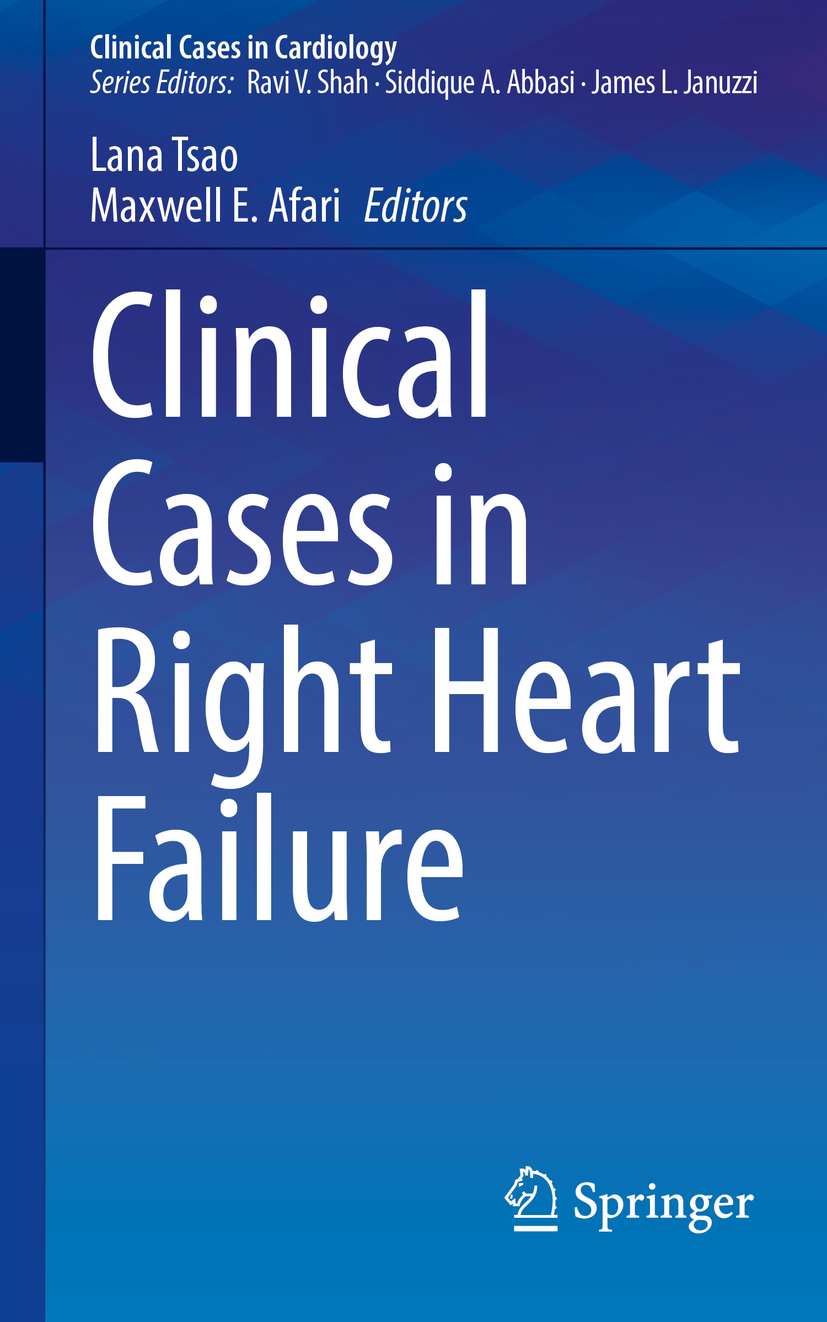
Clinical cases are a key component in modern medical education, assisting the trainee or recertifying clinician to work through unusual cases using best practice techniques. Cardiology is a key discipline in this regard and is a highly visual subject requiring the reader to describe often very subtle differences in the presentation of patients and define accurately the diagnostic and management criteria on which to base their clinical decision-making.
This series of concise practical guides is designed to facilitate the clinical decision-making process by reviewing a number of cases and defining the various diagnostic and management decisions open to clinicians.
Each title will be illustrated and diverse in scope, enabling the reader to obtain relevant clinical information regarding both standard and unusual cases in a rapid, easy to digest format.
More information about this series at http://www.springer.com/series/14348

This Springer imprint is published by the registered company Springer Nature Switzerland AG
The registered company address is: Gewerbestrasse 11, 6330 Cham, Switzerland
Historically, physicians have sought to separate the left ventricle and the right ventricle when discussing heart disease. Clinicians typically try to distinguish left heart failure from right heart failure and less frequently biventricular failure. Even experienced practitioners find the management of right heart failure daunting due to its associated morbidity and mortality. Hepatic and renal dysfunction is often present in parallel. Indeed, once the right heart is failing, patients are on a rapid decline and increasingly difficult to manage. The aims of this book edited by Afari and Tsao are to educate the reader about the multiple presentations of right heart failure and to recognize specific clinical scenarios that will lead to a precision medicine approach to treatment. Indeed, astute clinicians should make every effort to protect the right ventricle (prevention) when possible. They must realize the right ventricle may be quite resilient when dysfunctional, and has the capacity to recover to a significant degree when provided the right management [1].
Why has the right ventricle been ignored until recently? The right ventricle has a complex anatomic structure. Its geometry has rendered quantitative imaging techniques standard for the left ventricle very challenging when imaging the right ventricle. Understanding the techniques and limitations of imaging the right ventricle is paramount knowledge necessary for the clinician. Serial imaging also plays a key role in assessing right ventricular recovery and reserve. A most challenging, perplexing, complex clinical question is to determine if the right ventricle has the capacity to improve when dysfunctional if a primary treatment strategy is deployed upstream. The most poignant example would be predicting recovery of right ventricular function in a patient being considered for a left ventricular assist device (LVAD) with evidence of right heart failure. As described in this book, new advanced imaging techniques and risk stratification applied in various clinical scenarios will provide the guidance needed for successful management. This book is timely as we are now immersed in a growing array of percutaneous techniques to treat valvular heart disease. These innovative techniques mandate the understanding of right ventricular function as well as the complex interaction between the right and left ventricle. Emerging data has informed clinicians that understanding the right ventricle might be the central discriminating factor to predict the success and outcomes for most patients being considered for a variety of heart failure treatments including LVAD, valve surgery, percutaneous mitral valve devices, cardiac resynchronization device, coronary artery bypass, lung transplant, and others.
The chapters in this book will provide an understanding of important clinical scenarios including cardiac transplantation, mechanical circulatory support, pulmonary hypertension, congenital heart disease, valvular heart disease, and unique conditions isolated to the right ventricle. Today, there is a greater appreciation of the central role of the right ventricle in the pathophysiology of heart failure and its impact on hepatic and renal function [2, 3]. The right ventricle should be thought of in parallel and not in isolation. The right ventricle is of central importance in cardiovascular pathophysiology; thus, general and heart failure cardiologists need to strive to master the right heart and understand its potential to fail. Longstanding dogma has dictated that treatment of right heart failure consists of cardiac glycosides, diuretics, and treating underlying left heart disease when right ventricular failure is present. Fortunately, as described in this book, a plethora of effective and emerging treatments and imaging modalities now enable the clinician to recognize, protect, and treat more effectively right heart failure.
The editors have a longstanding interest and appreciation for the importance of the right ventricle and are experienced and astute heart failure cardiologists. Treating right ventricular disease requires a consummate clinician to synthesize the composite clinical data and recommend the most appropriate management which is frequently a daunting task. This book provides the knowledge to provide a framework to recognize, understand, and manage right heart failure encompassing the diverse clinical scenarios.
Font size:
Interval:
Bookmark:
Similar books «Clinical Cases in Right Heart Failure»
Look at similar books to Clinical Cases in Right Heart Failure. We have selected literature similar in name and meaning in the hope of providing readers with more options to find new, interesting, not yet read works.
Discussion, reviews of the book Clinical Cases in Right Heart Failure and just readers' own opinions. Leave your comments, write what you think about the work, its meaning or the main characters. Specify what exactly you liked and what you didn't like, and why you think so.

